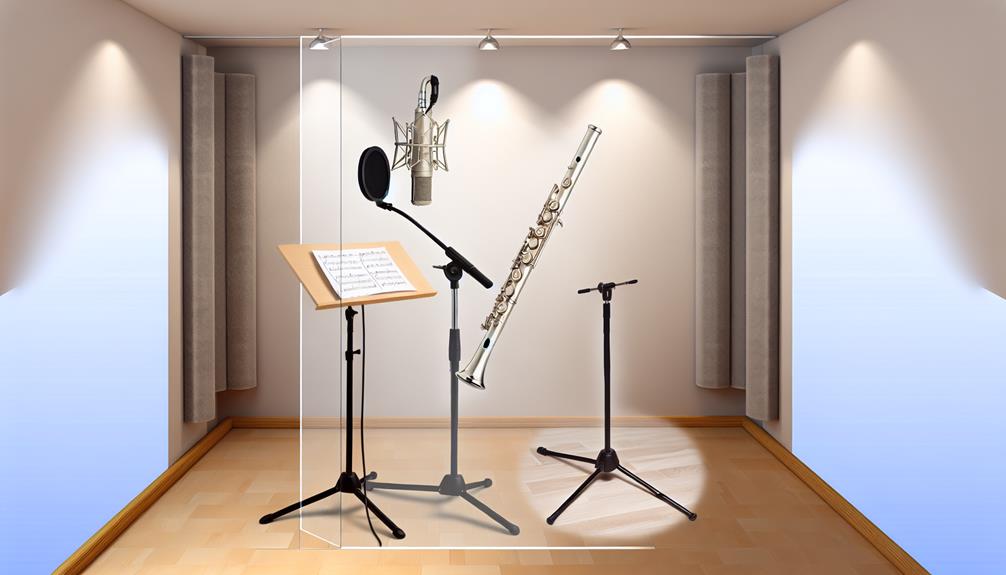Exploring the top 10 intermediate flute pieces is akin to embarking on a musical journey that intertwines technical prowess with emotional depth. From Mozart's timeless elegance to Doppler's vibrant pastoral imagery, these compositions offer a rich tapestry of musical challenges and expressive possibilities. Each piece not only demands technical proficiency but also invites the player to delve deeper into the nuances of musical interpretation and historical context. As flutists navigate through these renowned works, they uncover a wealth of artistic growth and discovery that transcends mere notes on a page, making the journey of mastering these pieces a truly rewarding endeavor.
Key Takeaways
- Faure's Fantaisie: Romantic flair, lyrical melodies, technical challenges for intermediate players.
- Griffes' Poem: Blend of late Romanticism and impressionistic influences, demands emotional depth and artistry.
- Bach's Sonata in E Minor: Baroque complexity, dynamic control, technical agility, expressive ornamentation.
- Poulenc's Sonata: Neoclassical clarity with emotive depth, technical challenges, delicate balance required.
- Andersen's 24 Etudes for Flute: Comprehensive technical development, historical relevance, enhances expressive possibilities.
Mozart's Flute Concerto in D Major
Mozart's Flute Concerto in D Major stands as a timeless masterpiece that showcases the brilliance of the flute as a solo instrument within the classical repertoire. Written in 1778 during the Classical period, this concerto reflects the elegance and refinement of the era's music. The historical context of this piece provides insight into the stylistic elements that Mozart incorporated, such as the use of elegant melodies and clear-cut phrasing.
When delving into the performance techniques of Mozart's Flute Concerto in D Major, flutists are presented with a myriad of musical interpretation and articulation choices. The concerto demands a delicate balance between technical precision and expressive phrasing. Players must navigate the intricate passages with agility and grace, while also infusing each note with emotion and clarity. Musical interpretation plays a crucial role in bringing out the nuances of Mozart's composition, allowing performers to convey the depth and complexity of the music.
Regarding articulation choices, flutists must make decisions that enhance the overall musicality of the concerto. Selecting the appropriate articulation, whether it be staccato, legato, or a combination of both, can significantly impact the interpretation of the piece. By carefully considering these choices, performers can bring out the dynamic contrasts and lyrical qualities present in Mozart's Flute Concerto in D Major, captivating audiences with a captivating and memorable performance.
Bach's Sonata in E Minor
Exploring the realm of classical flute repertoire further, Bach's Sonata in E Minor emerges as a significant work that offers flutists a rich tapestry of musical expression and technical challenges. This masterpiece by Johann Sebastian Bach showcases the depth and complexity of Baroque music, making it a must-know piece for intermediate flute players. The Sonata in E Minor is a treasure trove of expressive phrasing and dynamic contrasts, allowing performers to delve into the intricacies of Bach's compositions while honing their skills.
To highlight the importance of dynamics and phrasing in Bach's Sonata in E Minor, let's look at how these elements contribute to the overall performance:
| Aspect | Description | Importance |
|---|---|---|
| Dynamics | The Sonata requires precise control over volume, emphasizing the contrast between soft and loud passages. | Essential for conveying emotion and highlighting musical structure. |
| Expressive Phrasing | Players must master legato and staccato articulations to convey the lyrical and rhythmic elements of the piece. | Brings out the nuances of Bach's intricate melodies and rhythms. |
| Technical Agility | The Sonata challenges flutists with rapid passages and intricate ornamentation, requiring technical precision and agility. | Enhances the player's dexterity and control over the instrument. |
In mastering Bach's Sonata in E Minor, flutists not only enhance their technical abilities but also deepen their understanding of Baroque music's expressive potential. This piece serves as a stepping stone for players looking to expand their repertoire and delve into the rich world of classical flute music.
Faure's Fantaisie
Faure's Fantaisie stands as a captivating gem in the repertoire of intermediate flute pieces, showcasing the lyrical beauty and technical prowess required of flutists. This enchanting piece, composed by Gabriel Faure in 1898, is a testament to the Romantic era's influence on French music. Interpretation of Faure's Fantaisie requires a delicate balance between expressing the lyrical melodies and executing the intricate passages with precision. Flutists exploring this work must master techniques such as phrasing, dynamics, and ornamentation to convey the piece's emotional depth effectively.
When comparing Faure's Fantaisie to other works of the era, its unique blend of expressive melodies and virtuosic passages sets it apart. Understanding the historical context in which Faure composed this piece provides valuable insights into his artistic intentions and influences. The performance challenges present in Faure's Fantaisie demand a thorough musical analysis to navigate the shifting moods and technical demands seamlessly.
Moreover, Faure's Fantaisie's influence on modern compositions is notable, inspiring contemporary composers to explore similar lyrical and technical elements. This piece also offers collaborative opportunities for flutists to perform with pianists, further enhancing their musical experience. With its pedagogical value and potential for recital programming, Faure's Fantaisie remains a cherished and essential piece in the intermediate flute repertoire.
Debussy's Syrinx
Debussy's Syrinx, a seminal work for solo flute composed in 1913, stands as a cornerstone of Impressionist music, embodying a profound exploration of timbre and expression in a monophonic setting. This piece, which captures the essence of Greek mythology through its title referencing the story of the amorous pursuit of the nymph Syrinx by the god Pan, delves into the depths of symbolism. Each note and phrase within Syrinx is laden with layers of meaning, inviting the performer to unravel its mysteries through thoughtful interpretation.
Exploring symbolism in Syrinx goes hand in hand with the use of interpretive techniques to convey the nuances of the narrative it seeks to portray. The performer must delve into the emotional undercurrents of the music, painting a vivid sonic landscape that evokes the pastoral scenes of ancient Greece. Techniques such as dynamic contrasts, rubato, and delicate phrasing are essential in bringing out the subtleties of Debussy's composition.
Interpreting Syrinx requires a deep understanding of Impressionist aesthetics and a keen sensitivity to the nuances of expression. The flutist must embody the spirit of the nymph Syrinx, conveying her emotions, fears, and desires through each breath and gesture. By mastering the interpretive techniques embedded in this piece, the performer can truly unlock the beauty and depth of Debussy's masterpiece.
Griffes' Poem
Griffes' Poem stands as a compelling showcase of lyrical elegance and emotional depth within the flute repertoire, captivating both performers and listeners alike with its rich harmonies and evocative melodies. Composed by Charles Tomlinson Griffes in 1918, this piece combines elements of late Romanticism with impressionistic influences, creating a lush and poignant musical landscape for the flute.
- Symbolism in Griffes' Poem
- The piece is often seen as a musical representation of the poem 'The White Peacock' by D.H. Lawrence, evoking themes of beauty, longing, and introspection.
- Griffes' use of chromaticism and modal mixture adds layers of complexity, symbolizing the intricacies of human emotions and experiences.
- Flute Technique in Griffes' Poem
- The work challenges flutists with its demanding lyrical lines that require both technical precision and expressive phrasing.
- Griffes incorporates extended techniques such as flutter-tonguing and harmonics to enhance the ethereal quality of the music.
Griffes' Poem not only showcases the performer's technical abilities but also invites them to delve into the emotional depth of the music, creating a profound connection with both the audience and the essence of the piece. This composition remains a staple in the intermediate flute repertoire, offering players a platform to explore the nuances of expression and artistry within a captivating musical framework.
Poulenc's Sonata
A cornerstone of the flute repertoire cherished for its intricate interplay of melodic lines and dynamic contrasts, Poulenc's Sonata exemplifies the fusion of neoclassical clarity with emotive depth. Francis Poulenc, a prominent figure in 20th-century classical music, composed this Sonata in 1957-58 for flute and piano. Exploring Poulenc's style reveals his unique ability to blend elements of traditional structure with modern harmonies, creating a work that is both intellectually engaging and emotionally evocative.
The Sonata consists of three movements: Allegretto malincolico, Cantilena, and Presto giocoso. Each movement presents technical challenges that require a delicate balance between precision and expression. The opening movement, Allegretto malincolico, demands a lyrical touch to convey its melancholic character effectively. The Cantilena showcases Poulenc's gift for crafting beautiful melodies, inviting the flutist to explore a range of colors and dynamics. In contrast, the Presto giocoso challenges players with its lively tempo and intricate rhythmic patterns, requiring agility and dexterity.
Analyzing technical challenges in Poulenc's Sonata offers an opportunity for growth and development for intermediate flute players. Mastering this piece not only enhances one's technical proficiency but also deepens musical sensitivity. Poulenc's Sonata stands as a significant work in the flute repertoire, inviting players to embark on a journey of discovery through its rich tapestry of sounds and emotions.
Doppler's Hungarian Pastoral Fantasy
Doppler's Hungarian Pastoral Fantasy captivates listeners with its evocative blend of Hungarian folk influences and pastoral imagery, showcasing the virtuosity and expressive range of the flute. The piece, composed by the Hungarian flutist and composer Franz Doppler, delves into the rich tapestry of Hungarian musical traditions, infusing the composition with lively rhythms and melodic motifs that transport the audience to the picturesque landscapes of rural Hungary.
- Exploring Hungarian influences: Doppler's composition takes listeners on a musical journey through the heart of Hungary, incorporating traditional folk melodies and dances that reflect the country's cultural heritage.
- Romantic virtuosity: The Hungarian Pastoral Fantasy is a testament to the Romantic era's fascination with technical brilliance and expressive playing, challenging flutists to demonstrate their virtuosic capabilities.
- Symbolism in music: Through the use of evocative themes and harmonies, Doppler weaves a narrative that transcends mere notes on a page, imbuing the music with deeper emotional resonance and symbolic meaning.
- Flute technique: The piece demands a high level of technical skill from the performer, requiring mastery of rapid passages, dynamic contrasts, and delicate ornamentation.
- Cultural appreciation: By studying and performing Doppler's Hungarian Pastoral Fantasy, flutists not only hone their musical abilities but also gain a deeper appreciation for the diverse cultural influences that shape classical music.
Andersen's 24 Etudes for Flute
Andersen's 24 Etudes for Flute present a comprehensive and challenging collection that serves as a cornerstone for developing flute technique and musicianship. These etudes offer a wealth of opportunities for flutists to refine their skills through a series of carefully crafted exercises that target specific aspects of playing. Technique challenges abound within these pieces, ranging from intricate fingerings to dynamic control, articulation, and breath support. Each etude is a miniature musical journey that not only hones technical abilities but also provides a platform for exploring a wide range of expressive possibilities.
Understanding the historical context in which Andersen composed these etudes adds another layer of depth to the learning experience. Andersen, a prominent Danish flutist and composer of the 19th century, crafted these etudes with a keen insight into the technical demands of the flute. His etudes have withstood the test of time, remaining relevant and essential for flutists seeking to elevate their playing. Moreover, modern adaptations and interpretations of these etudes continue to enrich the flute repertoire, showcasing the enduring appeal and versatility of Andersen's compositions.
Navigating the interpretation nuances within Andersen's 24 Etudes for Flute allows players to delve into the intricacies of musical expression while honing their technical proficiency. These etudes stand as a testament to the enduring legacy of Andersen's contributions to flute pedagogy, making them a must-know for intermediate players looking to advance their skills.
Hue's Fantaisie
"Hue's Fantaisie" is a captivating and technically demanding piece that showcases the virtuosity and expressive range of the flute. Composed by Georges Hue, this work provides a wonderful platform for intermediate flutists to hone their skills and explore the depths of musical expression. Here are some key aspects to consider when delving into the world of 'Hue's Fantaisie':
- Exploring interpretation: The piece offers a wide range of interpretive opportunities, allowing the player to infuse their personal touch and creativity into the music.
- Technique in 'Hue's Fantaisie': From rapid runs to delicate trills, this piece challenges the player's technical abilities, making it an excellent choice for those looking to enhance their flute technique.
- Analyzing musicality: Understanding the nuances of dynamics, articulation, and phrasing is crucial in delivering a compelling performance of 'Hue's Fantaisie'.
- Phrasing in 'Hue's Fantaisie': Paying attention to the shaping of phrases and the overall musical structure is essential to conveying the beauty and emotion of this piece.
- Expressing emotion: 'Hue's Fantaisie' offers a canvas for flutists to convey a wide array of emotions, from poignant lyricism to joyful exuberance, allowing for a truly immersive musical experience.
Taffanel's Andante Pastoral Et Scherzettino
Georges Hue's Fantaisie showcases the technical prowess and expressive depth of intermediate flutists, setting a high standard for musical exploration and skill development, which seamlessly leads us to discuss Taffanel's Andante Pastoral Et Scherzettino. Taffanel, known as the 'father of the French school of flute playing,' composed this piece in the late 19th century, a time when the flute repertoire was expanding, incorporating more virtuosic elements and expressive possibilities.
In Taffanel's Andante Pastoral Et Scherzettino, flutists encounter a rich tapestry of performance techniques that challenge both their technical abilities and interpretative skills. The Andante section calls for a lyrical and expressive playing style, requiring a deep understanding of phrasing, dynamics, and tone control to convey the pastoral imagery effectively. On the other hand, the Scherzettino demands nimble fingers and a playful interpretation, showcasing the flutist's agility and rhythmic precision.
Understanding the historical context in which Taffanel composed this piece is crucial for a nuanced performance. Taffanel, a prominent flutist and conductor in Paris, aimed to elevate the status of the flute as a solo instrument through his compositions and performances. By delving into Taffanel's Andante Pastoral Et Scherzettino with knowledge of the era's musical trends and performance practices, flutists can bring out the subtleties and nuances intended by the composer, enriching their musical interpretation and connecting with the historical roots of the piece.
Frequently Asked Questions
What Are Some Common Challenges Faced by Flute Players When Performing These Pieces?
Common challenges faced by flute players when performing pieces include mastering intricate fingerings, achieving seamless transitions between registers, maintaining breath control for long phrases, and interpreting musical nuances accurately.
Performance techniques such as embouchure control, dynamics, articulation, and phrasing are crucial for a successful rendition.
Developing a strong foundation in technique and musicality through consistent practice and guidance from a skilled instructor can help players navigate these challenges effectively.
Are There Any Specific Historical Anecdotes or Interesting Facts Related to These Compositions?
Delving into the historical context of these compositions unveils a rich tapestry of musical influences and composer inspirations. Each piece carries unique anecdotes, such as Debussy's fascination with the Javanese gamelan in 'Syrinx' or Faure's dedication to his teacher in 'Fantaisie.'
These anecdotes not only provide insight into the creative process but also offer a deeper appreciation for the pieces and the eras in which they were composed.
How Do These Intermediate Flute Pieces Compare to More Advanced Repertoire in Terms of Technical Difficulty?
When exploring nuances in flute repertoire, comparing techniques between intermediate and advanced pieces unveils a progression in technical demands. Intermediate works may focus on mastering fundamental skills like articulation and dynamic control, while advanced repertoire delves into intricate ornamentation, extended techniques, and complex rhythmic patterns.
The transition from intermediate to advanced pieces challenges flutists to refine their technique, musicality, and interpretive skills, showcasing a natural evolution in their musical journey.
Are There Any Recommended Recordings or Interpretations of These Pieces by Renowned Flutists?
Interpretations of musical pieces by renowned flutists can breathe new life into familiar compositions, offering fresh perspectives and insights. Recommendations for recordings can vary depending on the desired style and interpretation sought by the listener.
Renowned flutists bring their unique artistry and expertise to these performances, showcasing their mastery of the flute and their ability to convey emotions through their playing. These recordings serve as inspiring examples for aspiring flutists to study and learn from.
What Inspired the Composers to Create These Particular Works for the Flute?
Composers draw inspiration from various sources when creating music for the flute. Influences can range from personal experiences, cultural traditions, to musical trends of the time.
The creative process involves translating these inspirations into artistic visions that embody the composer's emotions and storytelling. By delving into the composer's background, musical influences, and historical context, we gain a deeper understanding of what motivated them to craft these particular works for the flute.
Conclusion
In summary, these top 10 intermediate flute pieces offer a wealth of musical challenges and expressive opportunities for aspiring flutists.
From Mozart's majestic melodies to Debussy's dreamy textures, each piece provides a unique insight into different musical styles and periods.
By mastering these works, flutists can enhance their technical proficiency and deepen their musical expression.
Dive into these delightful and diverse compositions to unlock your full potential as a flutist!





